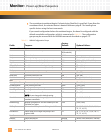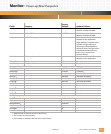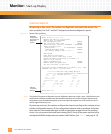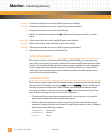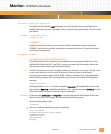
Monitor: Boot Commands
PmT1 and PmE1 User’s Manual 10002367-02
8-8
unsigned long CallAddress;
};
The structure consists of two unsigned long locations. The first is used for synchronization,
and the second is the entry address of the application.
The sequence of events used for loading an application is described below:
1 The host board waits for the target (this board) to write the value 0x496d4f6b (character
string “ImOk”) to “MagicLoc” to show that the target is initialized and waiting for a
download.
2 The host board downloads the application program over the bus, writes the application
start address to “CallAddress,” and then writes 0x596f4f6b (character string “YoOk”) to
“MagicLoc” to show that the application is ready for the target.
3 Target writes value 0x42796521 (character string “Bye!”) to “MagicLoc” to show that the
application was found. The target then calls the application at “CallAddress.”
When the application is called, four parameters are passed to the application from the non-
volatile memory boot configuration section. The parameters are seen by the application as
shown below:
Application(Device, Number, RomSize, RomBase)
unsigned char Device, Number;
unsigned long RomSize, RomBase;
These parameters allow multiple boards using the same facility to receive configuration
information from the monitor.
Also refer to the function BootUp on page 8-37.
booteprom
is an autoboot device that allows you to boot an application program from EPROM.
Description:
booteprom
In order for the monitor to jump to the start of the program, the following conditions must
be met:
• The start of the program is at FFF4,0000
16
.
• The first long word of the EPROM image contains a branch link instruction of the form
0100,10xx,xxxx,xxxx,xxxx,xxxx,xxxx,xx01
2
.
You can avoid jumping to an EPROM, even if a valid one is present, by changing the nonvol-
atile configuration parameter BootDev to something other than EPROM. The default setting
is to run an EPROM (especially if NVRAM is trashed).
Also refer to the function BootUp on page 8-37.





